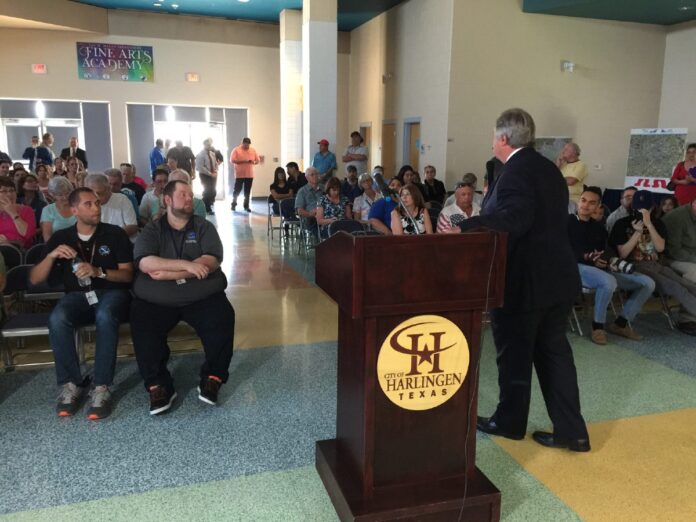HARLINGEN — Two weeks after what city officials describe as a 500-year rain event, fallout continued last night at a town hall meeting with around 400 residents, most of whom suffered flood damage to their homes.
The town hall at Lee H. Means Elementary School provided a background report from National Weather Service meteorologists on how 12 to 15 inches of water fell on parts of the city in under four hours and why there wasn’t more warning.
City officials also ran through the drainage improvements made since Hurricane Dolly hit in 2008.
“We wish tonight that we could tell you that we can do a program, a program of drainage in our city where we would never get any flooding,” said Mayor Chris Boswell. “Unfortunately, if we have another rain at some point like the one that we had two weeks ago, there’s going to be some flooding no matter what you do.
“We want to try to explain that,” he added. “But there are also things we are doing and can do and we want to make sure that you understand that’s a priority.”
For the first 45 minutes, officials ran through a detailed presentation of the second flood event in just over a year, using a PowerPoint computer display with maps and statistics.
But for many in the audience, frustrated by two weeks of hauling out ruined carpet, drywall and more from their homes, emotions ran high.
Criticism shared
John Pullin, who lives in Secluded Acres Subdivision, said the flooding problem was caused there by construction work on a nearby drainage canal which was left with a coffer dam blocking the canal while a crew added concrete to the ditch’s sides to improve water flow.
City officials conceded in case of a major rain event, the usual protocol was to breach these temporary coffer dams so they don’t block runoff.
In this case, they said, the storm was not a “significant predicted event” and the dams were not breached to allow runoff to bypass Secluded Acres.
“That’s the problem,” Pullin said. “You didn’t predict something and it cost me my home. And you’re expecting us to listen to all these projections? This is just fluff. You guys didn’t cover your butts on certain areas.
“Everything else doesn’t matter but water in our homes, we all had water in your homes,” he continued. “We don’t want it to happen again. I know you can’t take the water in my home, I know you can’t make it not happen, this last one. But can’t you at least make it so it doesn’t happen again?”
Pullin’s comments drew loud applause and whistles from a supportive audience.
“We understand that there’s nothing we can say up here to make you feel better if you get water in your house and you have damage to your property,” Boswell responded. “There’s really nothing we can say that’s going to make that right or make you feel better. What we are trying to do is communicate as much information as we can.”
John Purvis, who said he lives near the airport, also questioned officials.
“It seems like all of Harlingen dumps its water out there on all of us,” he said. “Can you tell me what y’all are doing out in the northeast side?
“At 2:30 in the morning the rain had stopped and the water was held out of my house,” he continued. “At six o’clock in the morning, I’ve got a kitty cat swimming up to my bed with a foot of water in my house. It seems somewhere behind us the City of Harlingen’s water backed up into all my neighbors right off the airport and behind us.”
City officials said there are plans to improve drainage to the north of the airport and the city owns the land in the areas which will be used as a catchment area.
The forecast
Earlier, National Weather Service meteorologists Robert Frye and Chris Birchfield talked about the early problems forecasters had in trying to get a handle on a storm which came out of nowhere and packed an unexpectedly strong punch.
Frye said the initial forecast was for a 50-percent chance of rainfall from 1 to 3 inches. Later, forecasters pushed that prediction to 4 inches.
A small boundary layer of cold air forced its way down from the north, setting off the rain event which dropped anywhere from 12 to 16 inches on some parts of the Rio Grande Valley.
“After the fact there were some things that we got right, some things that we got wrong, but that’s meteorology,” Frye said. “Unfortunately, it’s an imperfect science.”
Drainage work
City Manager Dan Serna also documented what the city has done with drainage issues since 2008 after Hurricane Dolly hit.
He said the city commissioned a study in 2008 to help guide officials on where to prioritize flood-mitigation money.
“In 2008, the mayor and city council at that time, gave us funding to do a master drainage study to look at the entire city as a whole,” he said. “We looked at 49 drainage ditches, 128 storm drainage systems … and at that time in 2008 dollars it was well over 50 million in improvements that were needed, that we identified.
“So what have we done? We’ve utilized that information from the study and went after grants,” he added. “Any time you can leverage money and do a project for 25 cents on the dollar, that’s what you want to do, and that’s what we have been doing.”
He said the city has spent $13.4 million on nine major drainage projects since then. Of that funding, $6.4 million came from federal grants.




